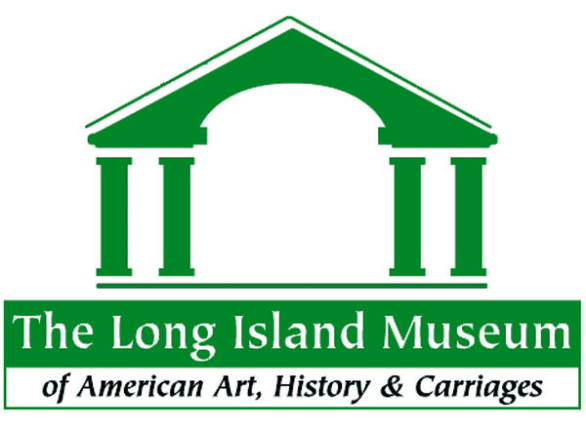Long Island Museum of American Art History and Carriages
AAQ Portfolio Sponsor: Riverhead Toyota
**************************************************************
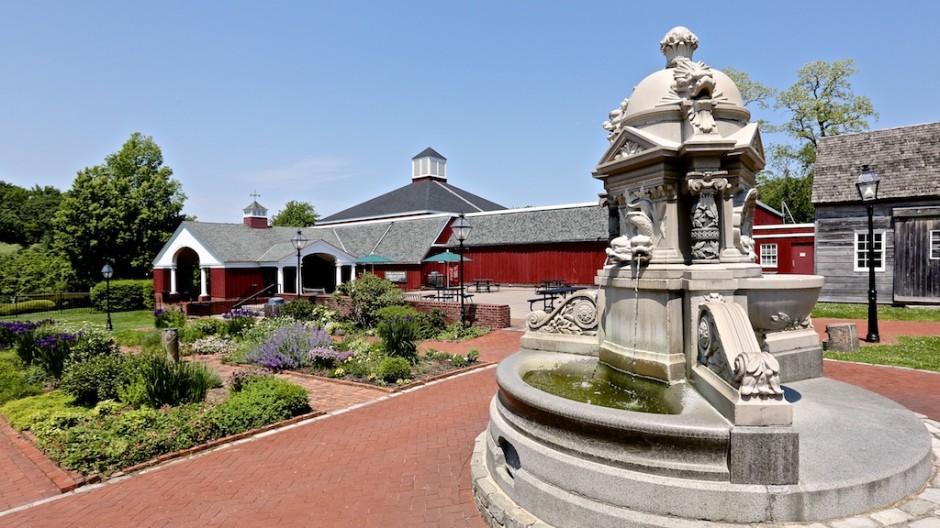
A Smithsonian Affliliate
——————————————————-
The largest and finest drove of equus caballus-drawn vehicles and related transportation artifacts in the country.
——————————————————-
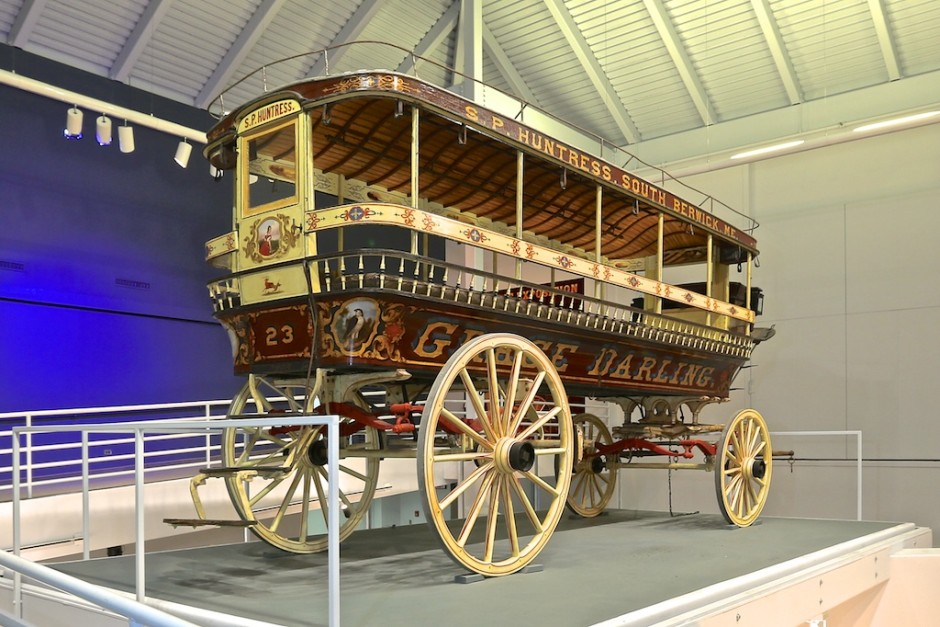
GRACE DARLING.Agree Carriage Builders, Concord, NH. Gift of St. Paul's School, 1952. Carriage Museum lobby.
The "Grace Darling," named later on the maritime heroine who persuaded her father, the keeper of a coastal lighthouse, to rescue shipwrecked passengers, was used by the Huntress family unit who operated a livery service from the 1860s to 1904 in South Berwick, Maine. It is reputed to accept delivered summer travelers to a steam packet, too named the Grace Darling. St. Paul's School, Concord, New Hampshire, later used the vehicle for transporting athletic teams and students to other school outings. Information technology is the largest vehicle in the drove, measuring eleven feet high, viii feet broad and xx-3 anxiety long.
____________________________________________
Going Places Gallery
America Gets Moving
Carriages – not cars – in one case ruled the road. These forerunners of automobiles and trucks were absolutely essential to American life in the 1800s. Carriages came in an amazing assortment of sizes, shapes and finishes. And they had a wide variety of uses. They moved people from place to identify, transported goods, demonstrated their owners' pride and accomplishments and provided new leisure opportunities. But carriages were not for everyone. Owning a vehicle, and the horse or horses to pull information technology, took a skilful bargain of money. Information technology might surprise you to know that a smaller percentage of the population and so owned carriages than at present own cars.
The standard of living of Americans improved greatly during the 1800s. As a result, more than and more people were able to ain vehicles and in turn were able to demand more than and amend roads. And every bit roads grew and improved, people could go more than and more than places and faster. This, in turn, greatly helped the developing American economic system, since horse-fatigued vehicles often provided the necessary connections between other forms of transportation – trains, canal boats and steamships – to get people and goods from point of origin to terminal destination.
A time line and a video, courtesy of the History Channel, identify the "carriage story" into a broader context of American history, and a colorful interactive map of Long Island presents the changing transportation networks in which equus caballus-fatigued vehicles played and so of import a role. "People stories" complement the vehicles by introducing someone associated with each, including owners, drivers and craftsmen.
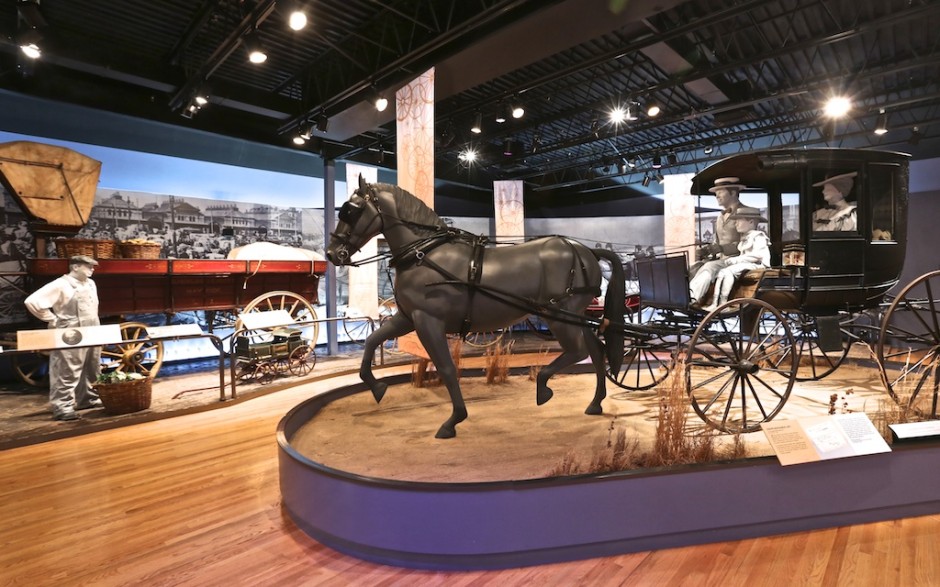
COUPE ROCKAWAY. A.S. Flandrau, New York, NY, 1871.
This vehicle type, known every bit the rockaway, originated on Long Island. It was named later the hamlet of Rockaway, Queens, then a fashionable beach resort. Wagon shops in nearby Jamaica perfected its design. An enclosed family vehicle, the rockaway's most distinguishing feature is its roof. The roof extends over the forepart seat to requite protection from the atmospheric condition to the driver.
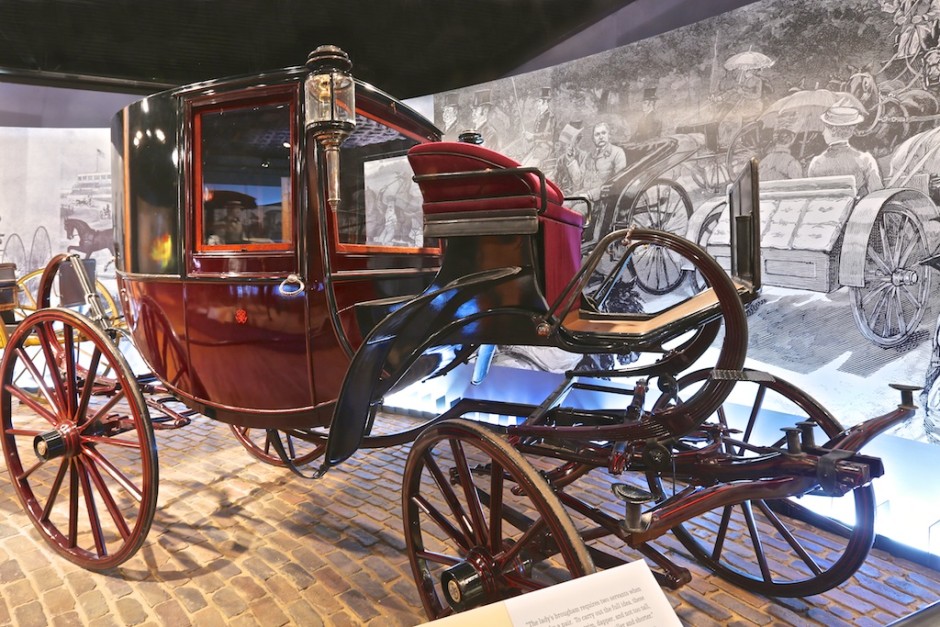
CHARIOT D'ORSAY, 1875-1885.Million & Guiet, Paris, France
The chariot type of carriage was recognized by its elevation, large wheels, and extreme elegance. Information technology was driven by a coachman and accompanied by footmen to help passengers. This carriage, with its silvery-plated hardware, belonged to William K. Vanderbilt, ane of the wealthiest men in America.
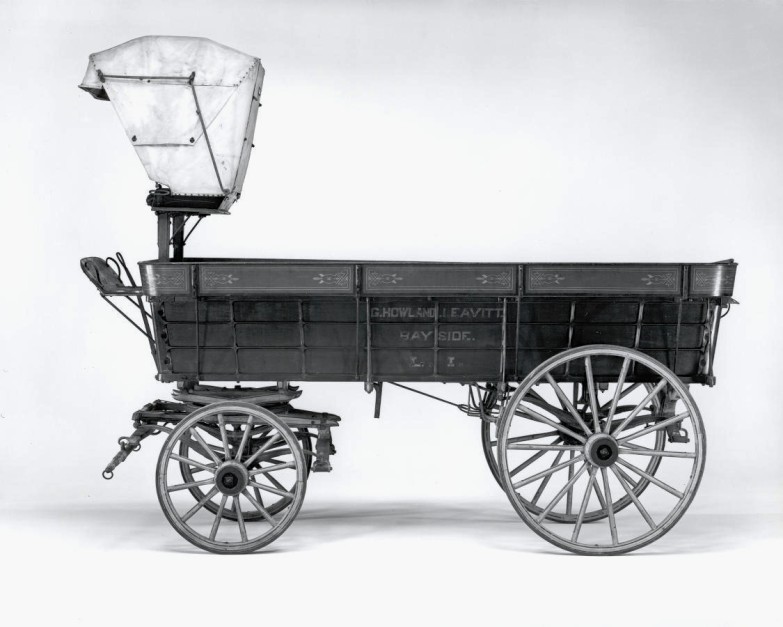
MARKET WAGON,ca. 1900. Unknown American maker. Gift of Mrs. Henry Lewis Three, G. Howland Meyer, S. Willets Meyer and Charles 1000. Meyer, Jr., 1950.
Market place wagons carried produce from farms to urban markets and manufactured appurtenances from factories to afar customers. Produce was typically stacked as high as possible and covered with a tarp secured past ropes. Sometimes the heavy-laden wagons were carried on flatbed railroad cars or aboard ferries. This wagon was owned past G. Howard Leavitt, a prosperous landowner in Bayside, Queens.
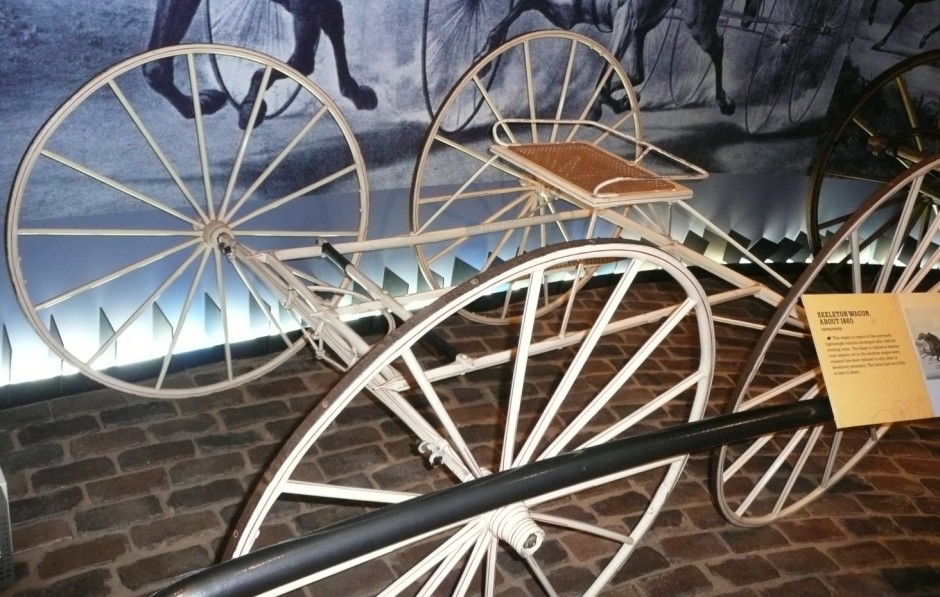
FOUR WHEEL SKELETON Railroad vehicle, 1855-1865. Unknown American maker. Museum Purchase, 1953.
This wagon is typical of the extremely lightweight vehicles developed after 1850 for trotting races. The shape is related to heavier road wagons, yet in the skeleton wagon every element has been reduced to but what is absolutely necessary.

WELLS FARGO COACH. Abbot, Downing & Co., Concord, NH. Gift of the Railway Limited Agency, 1951.
The overland limited coaches of Wells, Fargo & Company were disquisitional to the westward expansion of the U.s.. During the mining boom, these coaches transported millions of dollars worth of raw gilded bullion to exchange offices, too as postal service and passengers. When Wells Fargo announced overland rider service in April 1867, customers could travel from Sacramento to Omaha for $ 275. This coach could agree ix passengers in the interior and half dozen to ten on tiptop.
______________________________________________
A Carriage Exposition
Selling Carriages to a New America
This gallery is inspired by the display of carriages at the 1893 World's Columbian Exposition in Chicago. From oil lamps to Edison's electric lights…from farm buggies to Ford's Model T…about everywhere y'all looked, the Usa underwent profound changes between 1865 and 1918.
In 1865, family farms were the state'south economic heart; by 1918, factories had become the nation's driving economic force. Rapid industrialization and technological change turned out more goods using less labor at lower prices. The resulting new products were marketed through sleeky advert and displays to eager crowds of consumers at fairs, expositions and markets.
The most spectacular display of all was the Chicago World's Fair of 1893 attended by more than 30 million visitors. Hither, along the shores of Lake Michigan, where people saw cultural and technological treasures, they could also encounter the newest and best in the globe of carriages. Carriage entrepreneurs used the fair for the same purposes as other industries – to promote their wares and to sell, sell, sell.
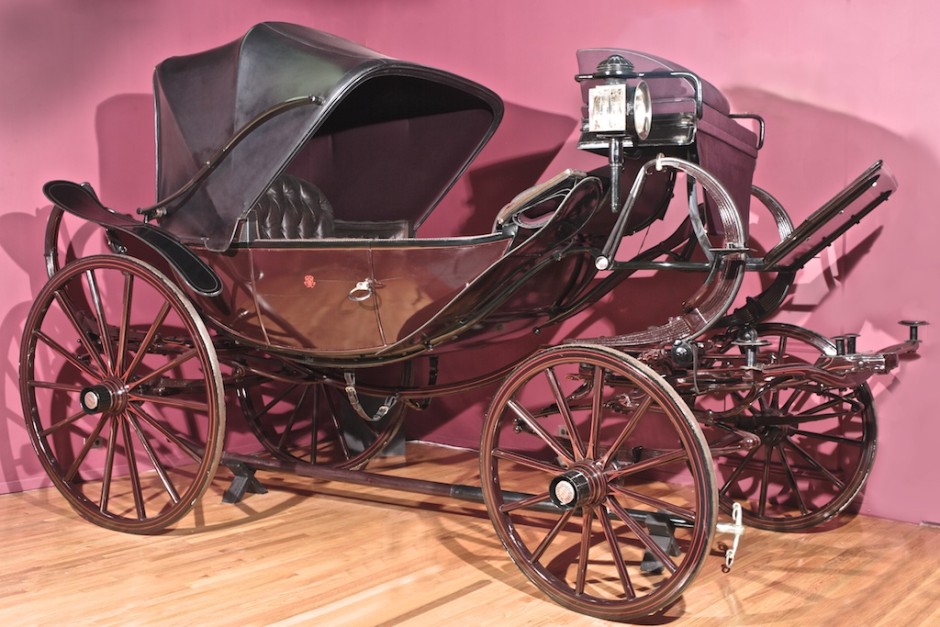
Calèche, ca. 1880. Million, Guiet & Company, Paris, France .
The French term calèche refers to the folding, collapsible hood found on certain types of horse-fatigued carriages.
A highly stylish mode of transportation during the nineteenth century, the calèche was intended for boondocks utilize, park outings, and formal social visits. Designed for warm weather, the open-air carriage afforded its passengers the opportunity to run into and to exist seen while out and about. Wealthy railroad tycoon William Thou. Vanderbilt originally owned this carriage and probable used it while traveling to and from his large Oakdale, Long Island, estate "Idle Hour."
In the early 1960s, inspired by this sublimely chic carriage, the world-renowned Paris fashion house Hermès introduced Calèche perfume. Press releases promoting the new scent explained "that this most elegant, modernistic perfume was named after a near elegant railroad vehicle of the nineteenth century" and described the perfume equally "a remarkably beautiful fragrance, neither heavy or outdoorsy … it is sophisticated and haunting, all pleasing, all-adult female." Today, Calèche perfume remains one of about popular Hermès products and yet features the image of this stylish vehicle.
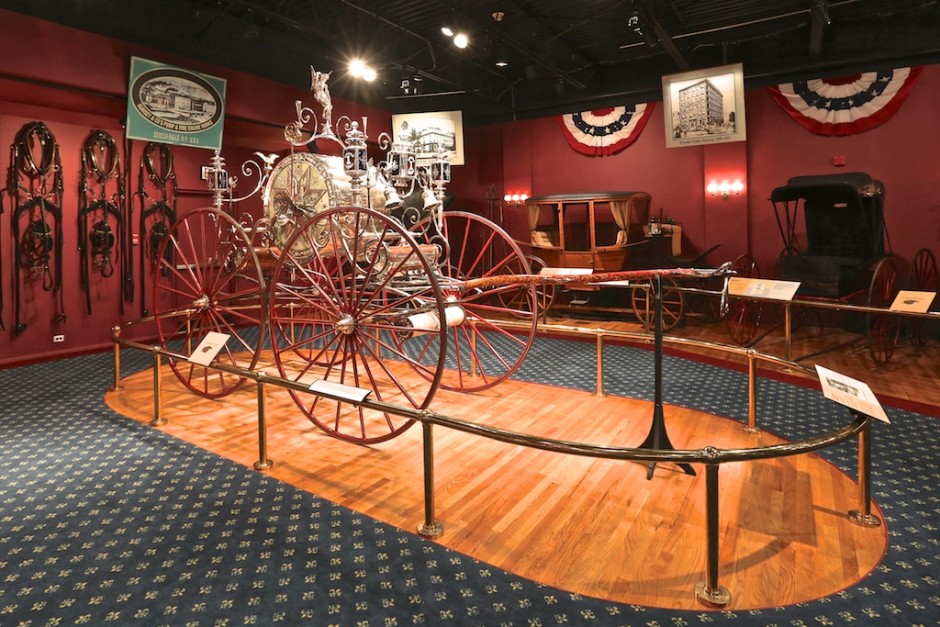
PARADE HOSE Wagon, 1870-1880. Rumsey Mfg. Co., Seneca Falls, NY.
This carriage, originally owned past Ringgold Hose Company #1, had silver plating from its axles to the statue of Cupid on height and mirrored on the ends of the hose reel. It was used by the Ringgold Hose Company in parades for over 70 years.

_____________________________________________________________
Making Carriages: From Hometown Store to Mill
The Studebaker Visitor, Southward Bend, Indiana
Carriage production changed drastically during the 19th century. At its outset, the manufacturing of carriages occurred most exclusively in small shops staffed by skilled craftsmen. Past century's stop however, large mechanized factories had all simply replaced small wagon shops.
The Studebaker Visitor serves as an excellent example of the changing economic landscape.
In 1852, with just $ 68 and the craftsman skills taught to them by their father, Henry and Clement Studebaker established a small-scale railroad vehicle shop in S Bend, Indiana. Before long concern boomed. By the first of the Ceremonious State of war in 1861, the Studebakers had sufficiently expanded production and gained a reputation for quality to be granted U.South. regime contracts for the production of war-related supply wagons, gun carriages and ambulances. During the remainder of the nineteenth century, the company continued to grow with Studebaker dealers and distributors popping upwardly throughout the Us and in several strange countries.
Studebaker was amidst the outset carriage companies to experiment with the "horseless railroad vehicle." The company start produced a series of electric automobiles started in 1902 and in 1904 switched to the production of gasoline powered vehicles. While Studebaker still manufactured wagons and carriages, their appeal gradually waned. In 1911, for example, the company's gross auction for automobiles was more than than triple that of their full sales of wagons and carriages.
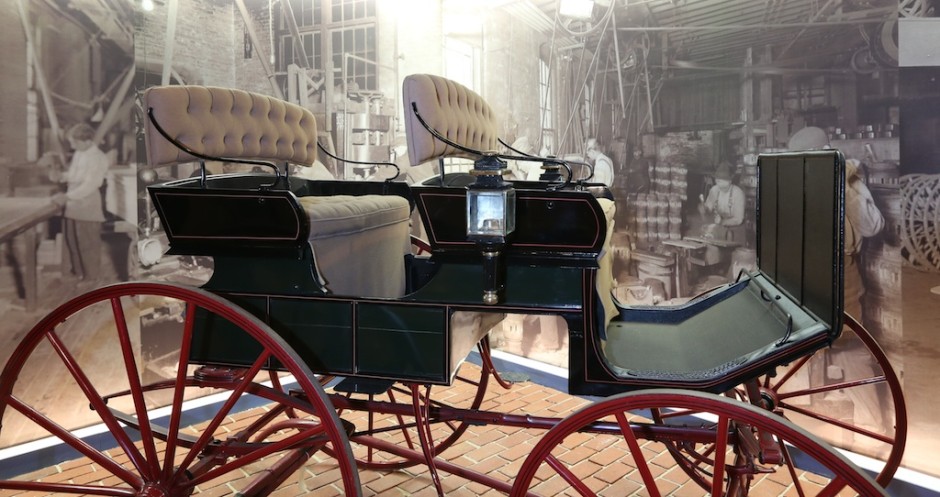
Two-SEAT Pleasure WAGON, 1895-1905.Studebaker Brothers. Souvenir of Ward Melville.
The pleasure railroad vehicle, a square-bodied, iv cycle passenger vehicle was widely used in New England in the nineteenth century. These were oft made with removable seats so that the inner space could be used for appurtenances and baggage. This wagon is painted "Brewster Greenish" and black, a popular color scheme for early automobiles as well equally carriages.
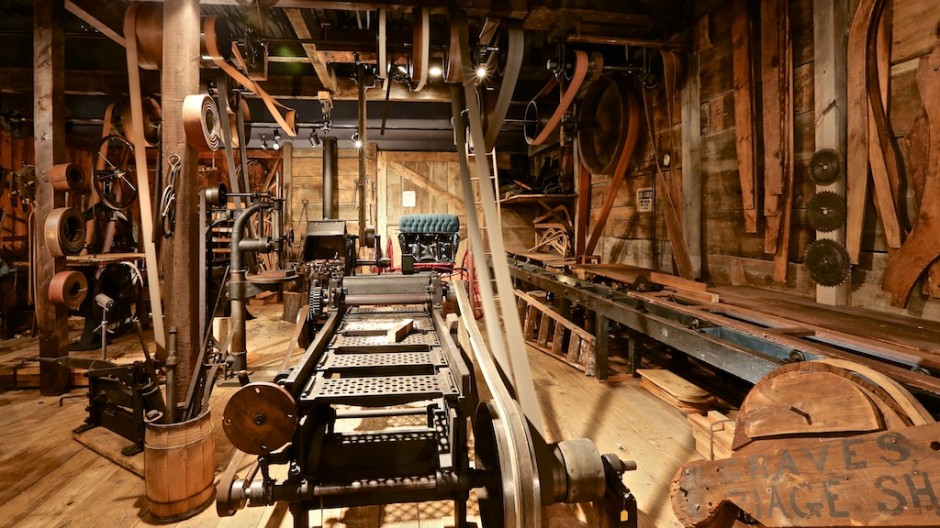
The Graves Carriage Shop, Williamsburg, Massachusetts
Small-scale-town wagon manufacturers once dotted the American landscape. But as automobiles replaced carriages, these became outmoded. So they were typically disassembled and their obsolete contents carted off to junkyards.
The Graves Wagon Store, reinstalled in role here, is a remarkable exception. The Graves family began making carriages in the mid-nineteenth century, when Norman Graves, a farmer, started to build and repair equus caballus-drawn vehicles as a sideline. In the 1870s, he built a mechanized shop in the eye of Williamsburg, Massachusetts, where he and others who worked with him manufactured buggies, farm equipment, market wagons and sleighs.
Norman Graves' descendants continued the enterprise. In addition to building new carriages, they repaired, repainted and reupholstered old vehicles. And they often took trade-ins equally partial payment for newer vehicles – just as car dealers exercise today. The Graves store remained ane of the master businesses in a minor town until the 1920s, when the family unit opened a separate automobile dealership side by side door, in effect joining the contest. The railroad vehicle store was and so locked up for more than 75 years, kept past the family for its historical and sentimental value. In 2003, its contents were donated to the Long Island Museum by Ralph Richards Graves and Nicole B. Graves, in memory of Norman F. Graves.
________________________________________________________________
The Streets of New York
In the late 1800s, horses and carriages ruled America'southward city streets…and what a scene it was! From sunup to sundown, cities buzzed like beehives. In New York, large horse-drawn omnibuses (the city buses of their day) and hacks (cabs) rumbled over Broadway. Yelling vendors, bellowing stagecoach drivers and thundering wagon wheels on cobblestones formed the urban soundtrack. Crossing the street was an even bigger hazard than it is now: among the jostling vehicles, New Yorkers had to stride effectually dung heaps from the metropolis'southward working horses.
Carriages were everywhere in the urban center and used for many purposes. Commitment wagons contained fresh groceries, newly-cutting lumber, supplies of every description. Elegant private coaches moved gracefully down Fifth Avenue, carrying rich residents to the function, the opera or a fancy repast. Heavy steam pumpers put out countless raging fires in the city's tenements. And many immigrant workers relied on simple two-cycle cars, moved by their own muscle.
New York was also at the heart of the railroad vehicle-making industry. In 1859, there were over 40 carriage manufacturers in the city, selling about 5,000 vehicles per year. Those numbers continued to rising over the adjacent decades. Past 1880, Manhattan and Brooklyn together had 249 carriage makers. Even after the rise of motorized streetcars, the subway, and automobiles in New York, carriages continued to play an important – if ever-diminishing – part. Into the 1940s, horse-drawn vehicles still delivered milk, water ice, and other basic items in spots where early on trucks had trouble maneuvering. But the days of a busy, noisy, and endless procession of horse-drawn carriages were long gone.
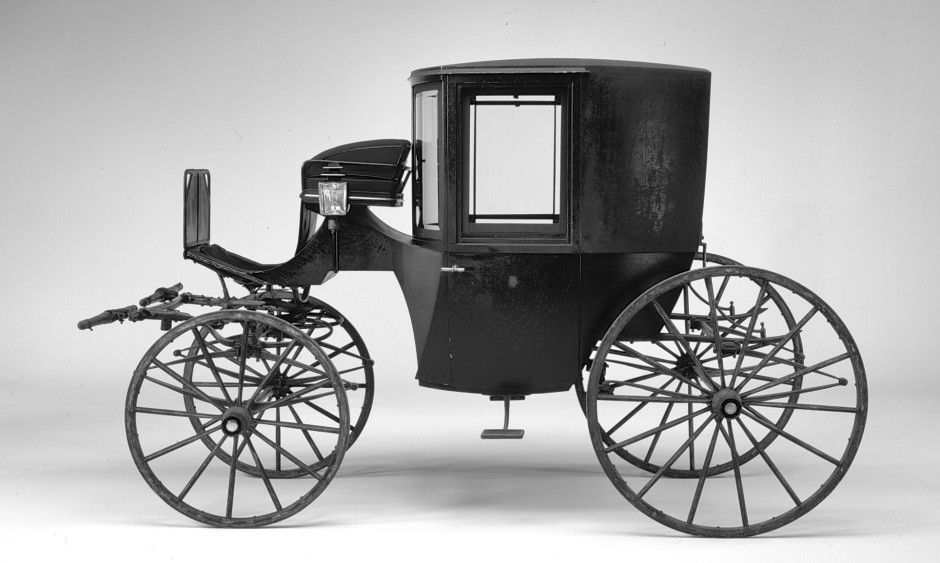
Round FRONT COUPÉ, ca.1860. Brewster & Company, New York. Souvenir of Ward Melville.
Literally a coach "cut" in half, the coupé is a minor carriage designed for but two passengers. However, a small hinged seat is hidden behind the wall roofing to accommodate an extra person if necessary. The interior is very elegant, with diamond-pleated burgundy satin, a mirrored vanity drawer, and a calling-bill of fare case with rich russet leather.

CONCORD COACH, 1866. Abbot-Downing Company, Agree, New Hampshire. Gift of Webster Knight II.
This nine-passenger double-decker was meant for long distances and heavy loads. Although the ride was undoubtedly rough, the coach is quite elegant inside: it is trimmed in red velvet and busy with lace and damask curtains. The coach'due south exterior was virtually probable painted by noted carriage painter John Burgham. I door features a peaceful seascape, but the other is decorated with a scene of an Indian set on, no doubt from the artist'south imagination.
Charles E. Fuller, proprietor of the Mattapoisett stage line in New Bedford, Massachusetts, had this coach repainted in nigh 1880 and collection it through the 1890s. The Concord Double-decker was the model for the stagecoach celebrated in literature and in and so many telly and motion picture westerns.
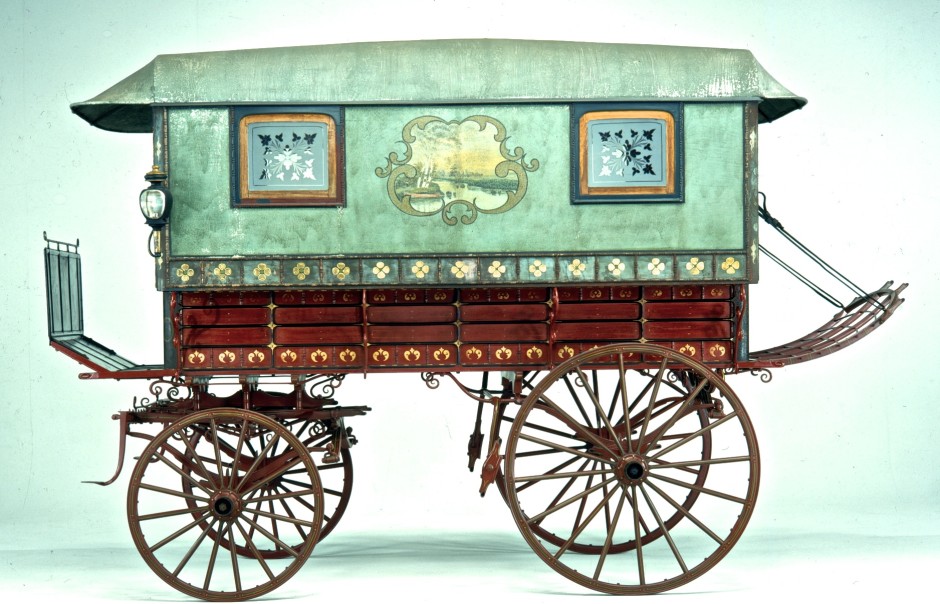
GYPSY WAGON, ca.1860. United States.
Gypsy wagons (besides sometimes called wardos) were institute in Romani encampments on the outskirts of urban areas in the United States after the Civil War. Often highly colorful and built for comfort, they were used for traveling, fortune-telling, and mobile residences. This wardo's body panels characteristic landscapes, seascapes, floral scenes, hunting scenes, a gypsy camp and horses. The front panels fold for access or closure to the interior.
This wardo belonged to Phoebe Stanley (sometimes referred to every bit "Gypsy Queen Phoebe"), from West Natick, Massachusetts. Her family belonged to the Romanichal (Romani people from the British Isles), and emigrated to New England in the 1850s. Phoebe married Thomas Stanley, a horse-trader by profession, whose family came to the United States from Liverpool, England, in 1857.
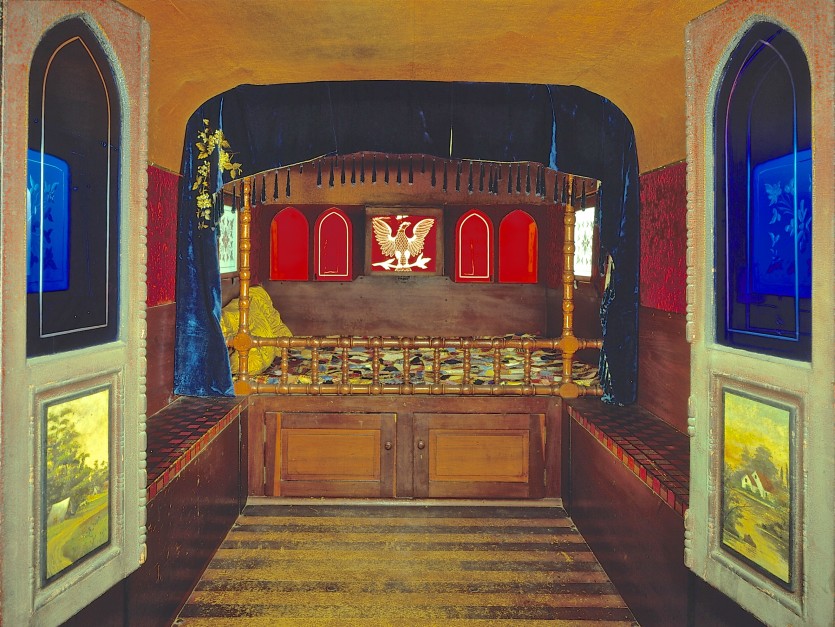
GYPSY Wagon Interior.
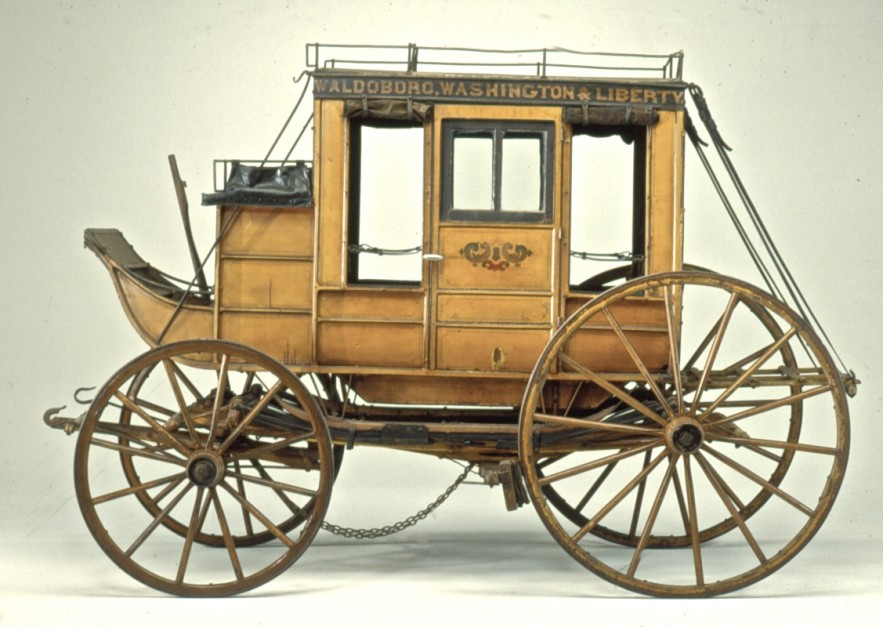
HACK PASSENGER Carriage, ca.1870. Abbot-Downing Company, Hold, New Hampshire.
A minor stagecoach, the hack passenger wagon seats only four and was pulled past a pair of horses. The body is suspended on iii-inch thick leather straps called thoroughbraces, which let it to hang above the wheels and absorb bumps by swinging gently. This sturdy vehicle was used to evangelize passengers, baggage and post.
Joel Chase Piece drove this bus vi days a week in Maine in the 1880s and 90s, starting at iv:xxx each morning to deliver mail, small freight and passengers, picking upwardly and delivering all along the route. As soon as they were quondam enough, each of his 5 sons learned to drive the route to make sure service was never interrupted.
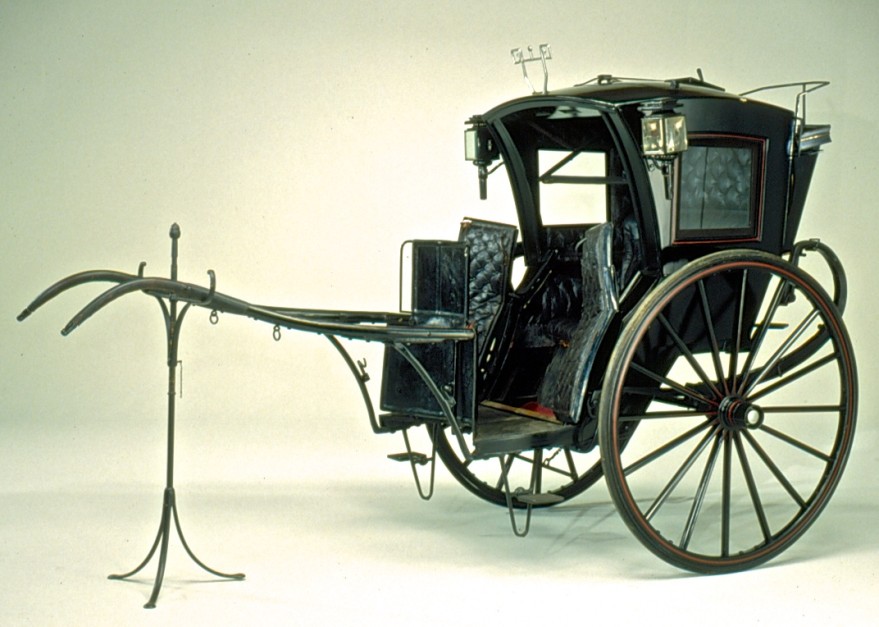
HANSOM CAB,1885-1895. Forder and Co., London.Souvenir of Ward Melville.
A cab for rent, the hansom was named for a British builder who patented its design in 1834. The driver sits above the rear wheels, enabling him to see clearly and to maneuver the cab through tight spaces. The driver can open and shut the doors from his perch. Hansom cabs were used on the streets of New York, too as other cities. Its slim pattern made it perfect for driving through urban crowds and narrow spaces. A modest window in the roof immune the rider to tell the driver his destination and to mitt him the fare.
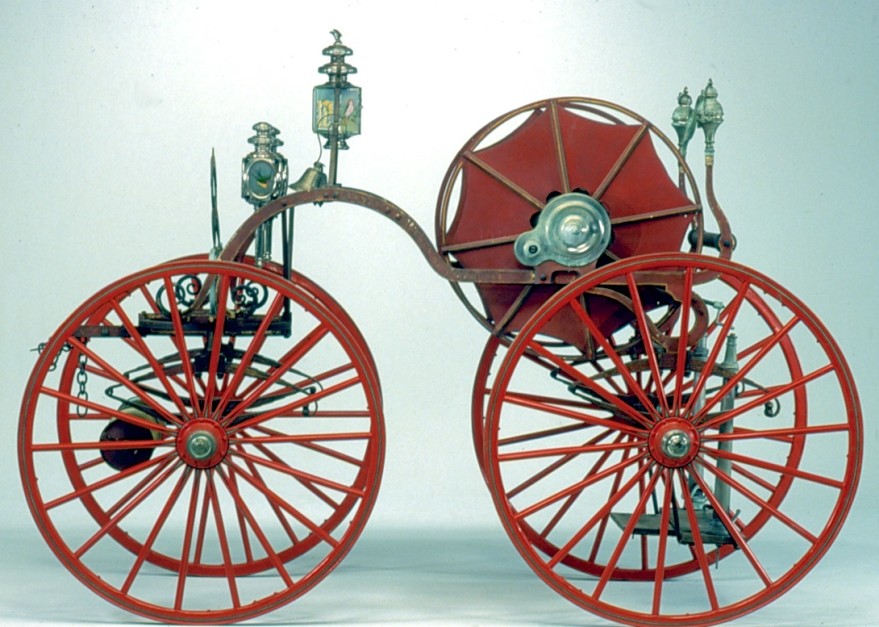
HOSE CART, 1870. United States. Gift of Clan of Exempt Firemen, Patchogue.
Nearly 19th century municipalities did not have fire hydrants and needed to become water from a swimming or stream. This was no trouble if the fire happened to be near a bounding main, merely if non, a hose was connected from the water source to the pumper. Hose carts efficiently accomplished this purpose, unreeling long lengths of hose very rapidly.
This hose cart was manufactured for Long Island'south Patchogue Fire Section and was used until 1904. Information technology could carry 900 anxiety of hose and was pulled by the firemen themselves rather than by horses. Four-bicycle hose carriages like this were known equally "spiders"; 2-wheel hose carriages were called "jumpers."
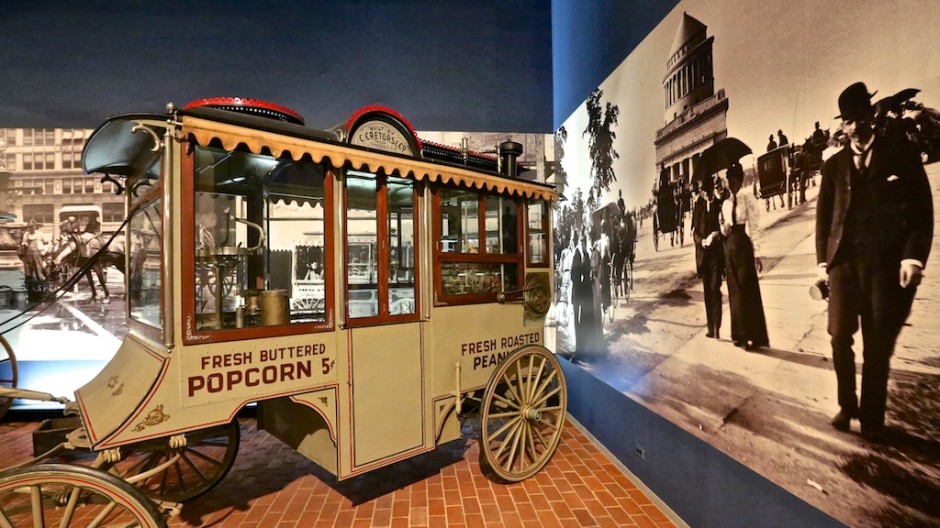
POPCORN WAGON, 1907. C. Cretors & Company, Chicago.
Salt and butter filled the air wherever this vehicle parked to sell its hot, tasty treats. Popcorn was a brand new snack food when Cretors introduced their wagons at the World's Columbian Exposition in Chicago, in 1893. The vehicle features a roll-down canvas awning, handy for either hot summertime days or a sudden July cloudburst. While waiting for their popcorn, kids watched "the Tosty Rosty" man – the smiling blimp clown and company trademark, you can see perched just higher up the motor. As the motor ran, the clown came to life, cranking a modest glass cylinder of peanuts.
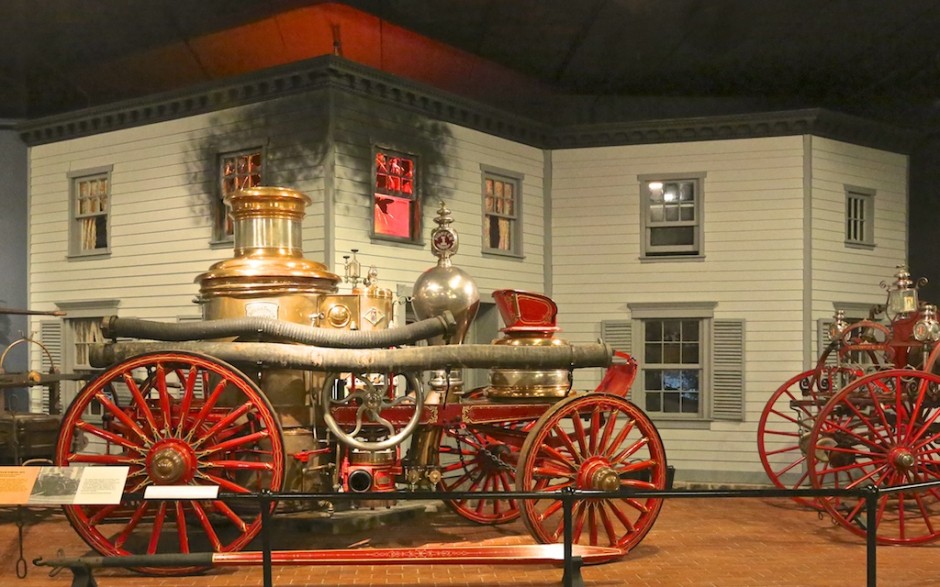
STEAM PUMPER, 1873. Amoskeag Manufacturing Company, Manchester, New Hampshire.
Although steam pumper technology was available in the The states by 1839, information technology took a while for information technology to catch on. Volunteer departments believed that man was better than machine and that the new pumpers might impede on their piece of work. This somewhen changed in many cities, including New York, which organized its offset fully functional, professional person fire section in 1865, and began using steam pumpers shortly thereafter.
This steam pumper was built in 1873 for the New Orleans Fire Company. Only weighing in at over 9,000 pounds and standing ten feet alpine, the engine was useless among the narrow and winding streets of the city. The engine was then transported back to the Amoskeag manufactory in New Hampshire where it was used to protect the factory and the city of Manchester from fires.
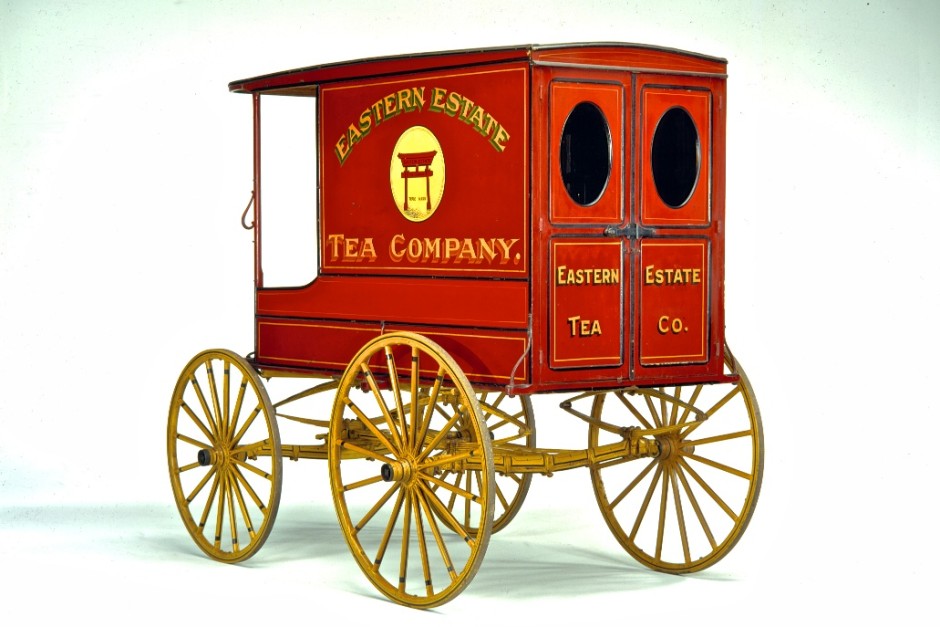
EASTERN Estate TEA Visitor Carriage, ca.1905. Biehle Railroad vehicle Visitor, Reading, Pennsylvania.
Like moving billboards, wagon sides were the great ad tools of their solar day. Businessmen took inspiration from elaborate trade signs, using a diversity of pigment techniques, colors, and trademarks to promote their companies for consumer'southward eyes. Eastern Estate Tea Company's lush red and yellow Pagoda logo – capitalizing the public's fascination with the Orient – was seen in dozens of cities across New York State by 1910, at the acme of the business'southward success. This vehicle carried many appurtenances, including tea, cocoa and spices, rice, maple syrup, peanut butter, and soap. Eastern Manor Tea Company was started by William Aitken, who expanded his concern from a small shop in Pennsylvania to a large, multi-urban center enterprise headquartered in Manhattan.
_____________________________________________________
Driving for Sport and Pleasure
Racing at breakneck speed around a curved dirt track…parading in well-appointed splendor through a big metropolis park…sleighing through the snowfall and water ice on a crisp winter's twenty-four hours – vehicles for sport and pleasure provided escapes into life'south most enjoyable diversions. The vehicles seen here include wintertime sleighs, pleasure wagons, and other carriages fabricated for carrying well-to-do passengers to fun-filled destinations like resorts and country picnics.
Vehicles for sport and pleasure looked and functioned differently from piece of work vehicles. They were oftentimes used in places removed from the city, especially in parks, estates, and on land roads. When Primal Park opened in 1858, New York City explicitly prohibited omnibuses and express wagons from inbound the park, as well equally "any cart, dray, railroad vehicle, truck, or other vehicle conveying goods"; only non-work-related carriages were permitted.
In the 1800s, railroad vehicle makers designed and made pleasure vehicles that were faster and more comfy, fifty-fifty on rough and uneven roads. Innovations to wheels, suspensions, shock absorption and interior comfort all improved the ride.
Owner-driven pleasure vehicles showcased the skills and mastery of their drivers, an abililty to handle both the horse and vehicle that earned them an honored status as a "whip." Whether driving a carriage harnessed to a single horse, a pair, a tandem, or four-in-hand, the "whip" needed to exist able to manage all sorts of challenges. High status was also achieved through a fashionable "turnout": the suitable standard and properly-dressed drivers, grooms, passengers, and horses, every bit well every bit the properly chosen harnesses, fittings and other accessories for specific pleasure vehicles.
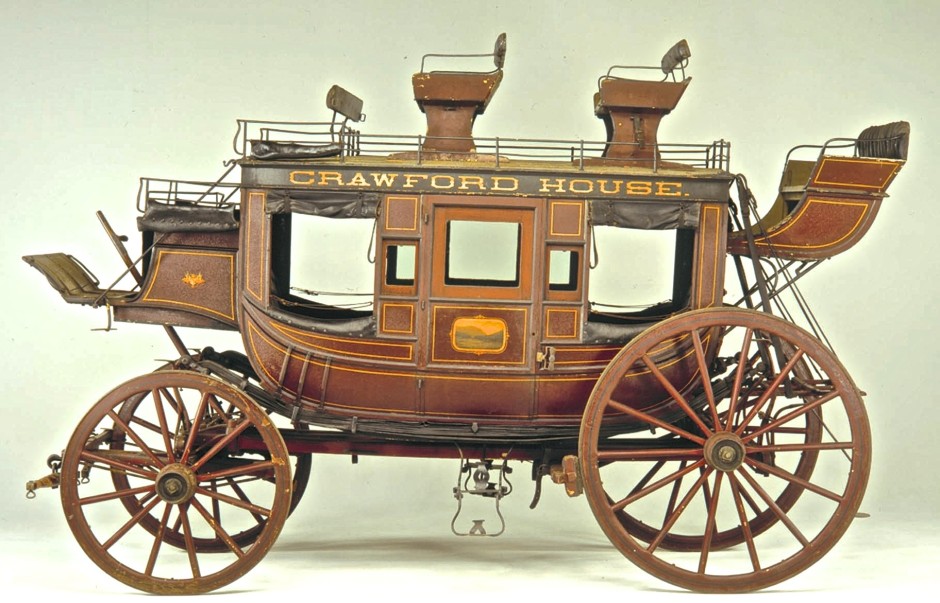
CRAWFORD Firm Omnibus, 1867. Abbott-Downing Visitor, Agree, New Hampshire.
Coaches such as this were ofttimes packed to capacity, with as many as 20 people and their baggage seated inside and perched on top. Leather straps under the vehicle, chosen thoroughbraces, an early daze cushion system, enabled the weighted-down vehicle to sway with the terrain and to ease the crude ride.
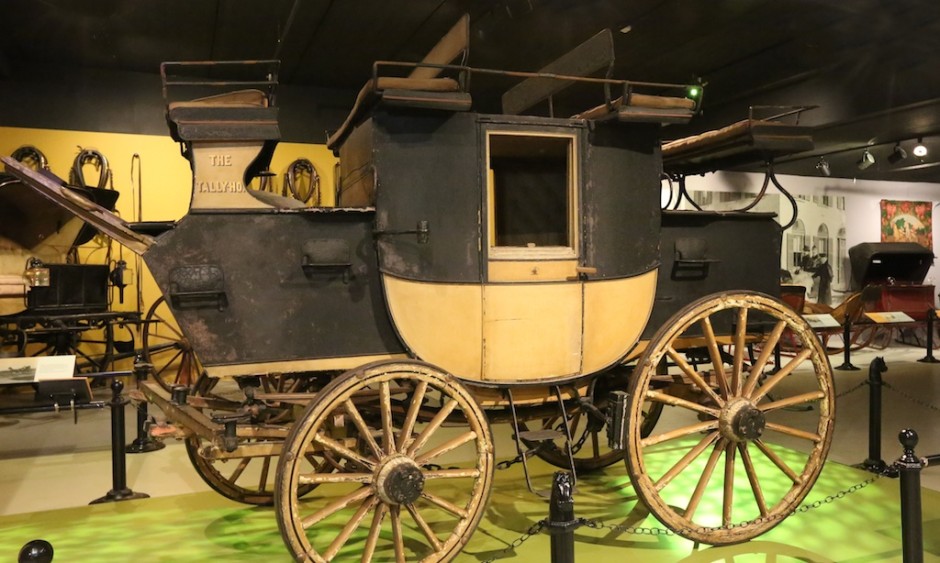
TALLY HO, 1875. Holland & The netherlands Builders, London, Great Britain. Gift of the Museum of the City of New York.
This is the most historically important vehicle in the museum's entire collection. Internationally famous, the Tally-Ho Route Coach was a catalyst of the road coaching movement in America, which hitting its pace in the 1880s. The vehicle was brought to this land by Col. Delancey Kane, a founder of the New York Coaching Club and the main force behind the popularization of American route coaching.
Written about widely in newspapers and prominent publications of the time, route coaching became a major event, engaged in by upper class gild figures and watched by nearly everyone. Road coaching took hold at a time that many Americans were feeling nostalgic for a seemingly simpler time in transportation, before phase coaches were supplanted by railroad travel. As Harper's Weekly put it, "genuine, healthful enjoyment tin can be derived from 1 ride out of Pelham Bridge and back on the top of Colonel Kane's motorcoach than from the whole flight railway trip from New York to San Francisco."
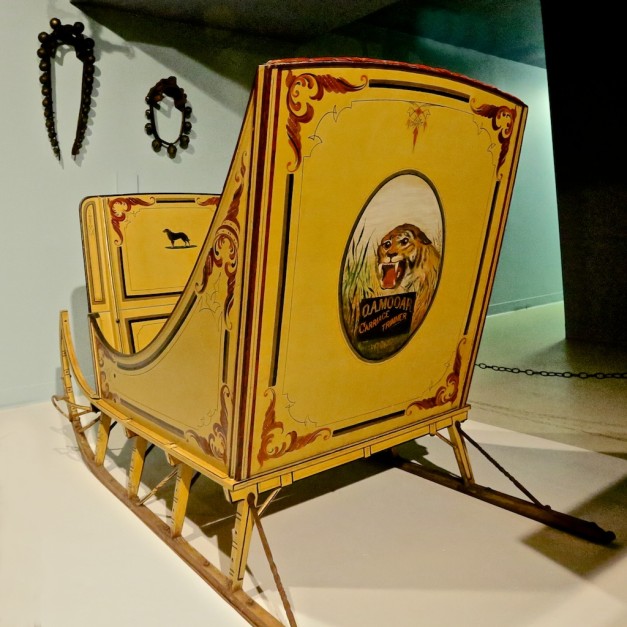
SLEIGH, 1830. United States.
Similar to larger trade vehicles, sleighs could become moving advertisements. Congenital decades before the Civil War, this sleigh was lavishly repainted for O.A. Moor, a wagon trimmer from Farmington Falls, Maine, in about 1875. It is decorated with coil work, vivid striping and an ornately painted tiger. The painter of the sleigh, Lemuel Hodgkins, signed information technology beneath the oval painting of the tiger. Hodgkins worked for his male parent's railroad vehicle-making business organisation, and later on became a school instructor and a real estate salesman in Aroostook County, Maine.
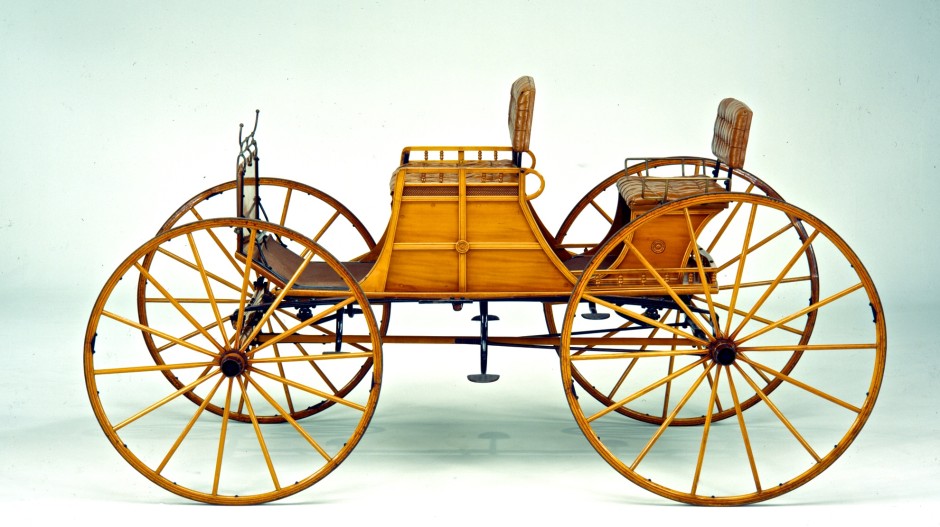
TRAP, ca.1890. Troy Railroad vehicle Works, Troy, New York.Gift of Katherine Thayer Hobson.
Traps were country pleasure driving vehicles that were sometimes used for hunting. A modest compartment in the back of the vehicle was sometimes used to house a dog, and the early traps would later go the more elaborate domestic dog carts in America. Traps could accommodate two to four passengers and were very piece of cake to handle. Traps ofttimes featured a rear seat that could be removed or shifted for passengers to exist able to ride backwards or forrard. This vehicle was used by a family in Washington County, New York.
___________________________________________
A Trip to Yesterday
Long Isle in the Carriage Era
In this exhibition, you begin your trip to the lost Long Island of a century ago through a re-cosmos of the old Stony Brook Station and see the actual Depot Wagon in which plow-of-the-century guests were transported from the Station to Stony Brook and other local villages.
The Village itself consists of 2-thirds-scale structures based on local buildings, circa 1900: the Old Stony Brook Post Role, the Eastward. E. Topping Store (Stony Brook), and the Samuel West Blacksmith Shop (Setauket), in addition to the Train Station.
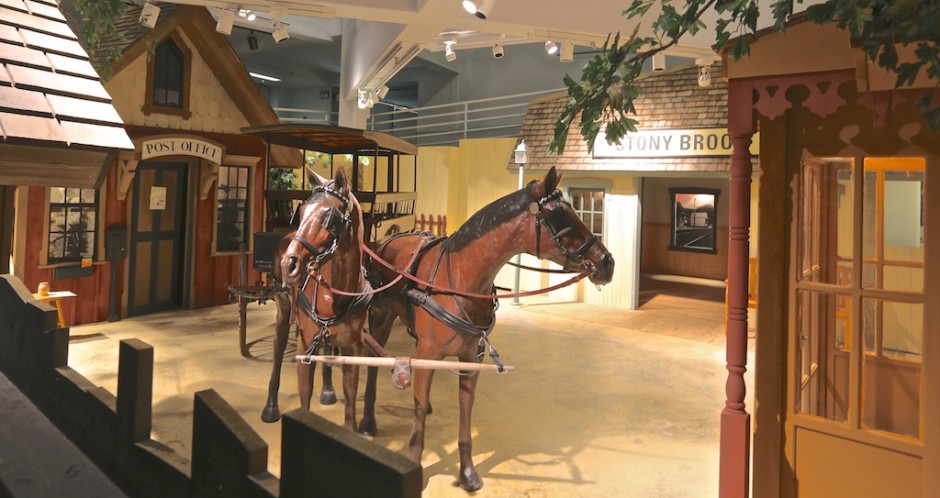
______________________________________________________
Gentleman'due south Coach House Gallery
Fashionable Homes for Carriages
With their beautiful façades and handsome hardwood interiors, charabanc houses provided stately comfort for carriages and horses…just not necessarily for the people who worked – and sometimes also lived – within.
At a fourth dimension when the wealthiest 1% endemic more than than fifty% of the nation's personal holding (including many of the largest, nigh opulent estates on Long Island'south Gold Coast), carriage houses were the ultimate Gilded Age status symbols. "The seeds of social appetite," wrote author and editor James Garland in 1899, "are get-go sown in the stable." At its best, the private coach house projected an ordered formality that left zip to chance, with ample ventilation, lite and drainage to protect the expensive contents.
Merely those thousand structures did not run themselves. They depended on a huge corps of servants, from the lowest paid and least experienced stable boys to highly skilled older caput grooms. Despite charabanc house' splendid outer appearance, the work within was smelly, noisy, and intense at early on and late hours – all reasons why these structures saturday a practiced distance away from the main firm.
By the end of World War I, many estate owners were leaving their one thousand omnibus houses behind for new automobile garages, and their coachmen were becoming chauffeurs. The carriages were increasingly relegated to storage and gathering dust.
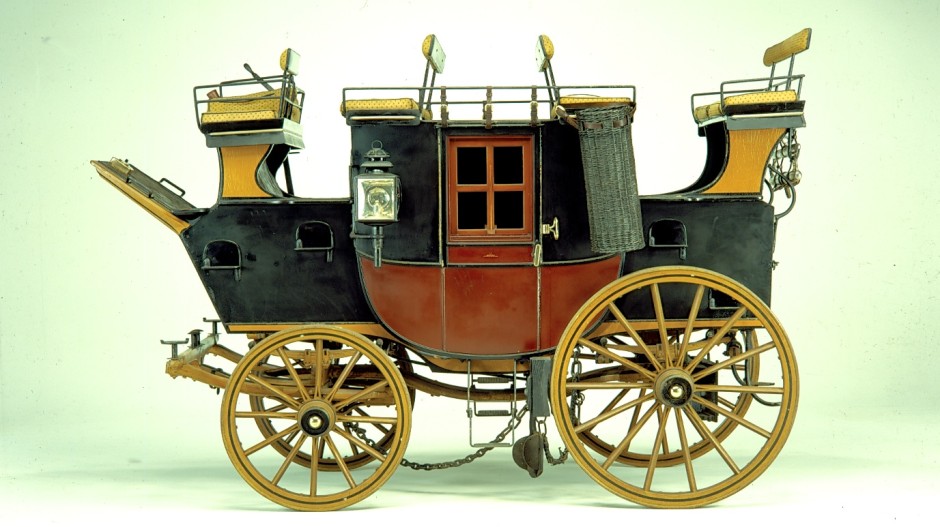
Route COACH, ca. 1920.Peters and Sons, England. Gift of Mrs. Joseph Wilshire.
Despite the inflow of the railroad and later the automobile, some members of the gentry in United kingdom and their counterparts in the United States clung nostalgically to the globe of road coaching and four-in-hand driving.
This vehicle, reputedly the last road coach fabricated in London, bears the phrase "Olden Time" on its rear panel. Information technology is equipped with mahogany wine-glass racks and a wicker handbasket for umbrellas. The makers, Peters and Sons, were leading English motorbus makers until their dissolution around 1930. One of the firm's clients was the British royal household.
______________________________________________________
European Vehicles Gallery
From parlors busy with One-time Master paintings to coach houses resembling castles, America'south Gilded Historic period elites craved European cultural refinements. Indeed, well-nigh styles of American luxury vehicles had their origins in the Onetime World – landaus, caléches, broughams, and chariots d' Orsay, to proper name a few. Ornate interiors, elaborate paint schemes, and even coats-of-arms seen on the panels of European coaches were adjusted by Americans, in order to associate their vehicles with old money, bluish blood and good sense of taste. In 1878, New York carriage maker Ezra Stratton wrote that the super-rich were "aping the European fashion, now driving through our streets in the most approved style."
Only imitation stopped brusk of duplication. Traveling overseas, America's wealthiest marveled at the startlingly unlike carriages they saw in London's Hyde Park and forth the Champs-Élysées in Paris. While their basic constructions were similar, European luxury vehicles, such as these, were heavier and featured more than ornate ornamentation – more extensive use of gilding, more elaborate pigment schemes, and more references to emblematic and classical figures.
Nigh of the European vehicles seen in this gallery were used by aristocrats or high officials on streets and promenades near their palaces and other halls of ability. Four of the carriages were owned past Prince Adalbert of Bavaria (1828-1875), used in his lifetime at Nymphenburg Palace in Munich. After his expiry, they saturday on the palace grounds gathering dust through two World Wars and did not arrive in the United States until 1959, when Dieter Holterbosch, a German executive with family ties to the Bavarian royals, purchased and displayed them at his Long Island estate at Belle Terre. He contributed them to this museum in 1966.

BERLIN Jitney,ca. 1775-1785.Unknown maker, France.
The pattern of the Berlin bus, of Prussian origin, represented a major innovation in carriage construction. The body of the vehicle was hung from leather straps or thorough braces, creating a smoother and more comfortable ride. This feature besides made the vehicle more maneuverable than its fixed suspension predecessors. This applied science would be used later in other European and American horse-drawn vehicles, before the advent of springs.
This coach was sent from France to Rome in 1785, where it was used past Cardinal Pianetti, Pro-Governor of Rome under Pope Pius 9. Much afterward, Colonial Williamsburg used it in its film The Making of a Patriot.

***********************************************

PRAIRIE Railroad vehicle
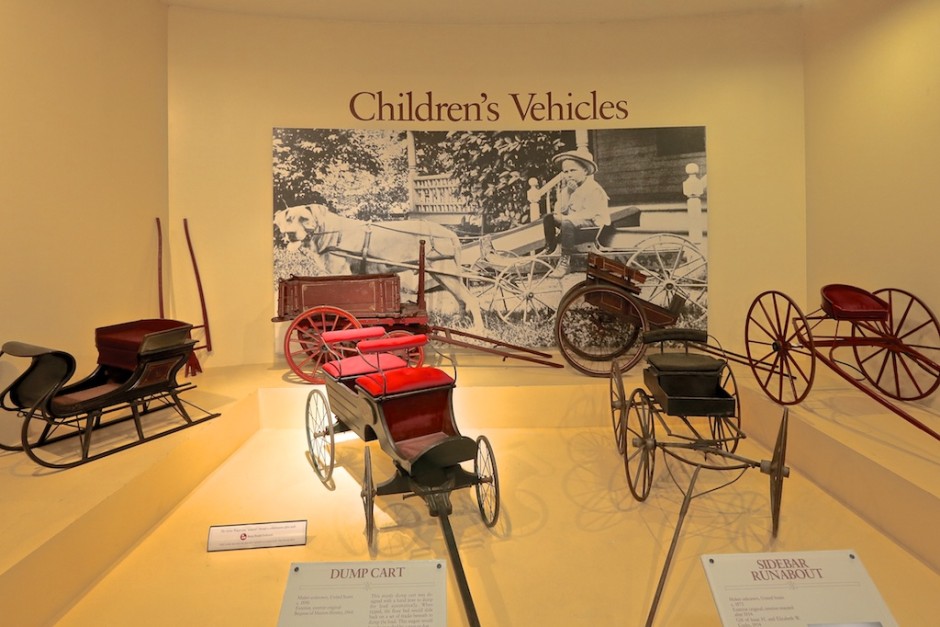
Children's Vehicles
Vehicles designed for children'due south pleasure, pulled by people, ponies, goats, or dogs, were miniature versions of vehicles used by adults for both piece of work and pleasance. They were made my major carriage manufacturers, too as by firms specializing in children's carriages, sleighs and sleds. These miniature vehicles were toys, only they also offered children the practical experience of handling reins, and sometimes the pleasure of driving.
—————————————————————
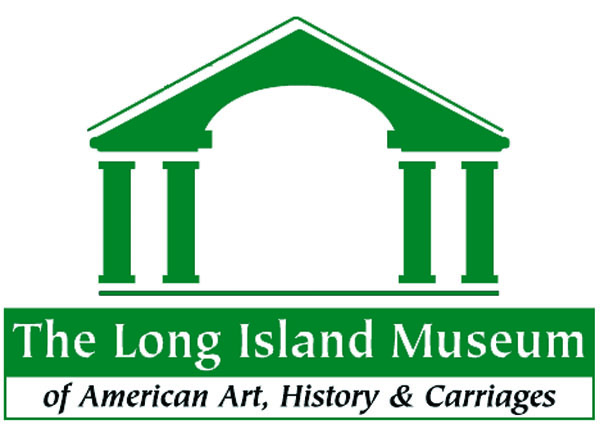
THE CARRIAGE COLLECTION
The extraordinary collection of horse-drawn vehicles at The Museums of Stony Brook [now the Long Island Museum] was begun past Ward Melville, a man fascinated past the past and committed to public education. He began in the early 1940s to collect the works of Stony Brook'due south nineteenth-century artist William Sydney Mount; by the mid-1940s, he was collecting carriages. Mr. Melville'south interest in collecting paintings and artifacts related to America's by was role of a trend of involvement in American history and artifacts that began in the late nineteenth century and adult rapidly in the twentieth century.
Mr. Melville nerveless Mountain'south paintings and drawings, also as objects that had belonged to Mount and his family. Profitable Mr. Melville in his fine art collecting was Richard McCandless Gipson, whose connoisseurship and talent for patient negotiation significantly contributed to the development of Mr. Melville's superb collection.
Mr. Gipson suggested to Mr. Melville that he might be interested in collecting carriages, observing in a letter to Mr. Melville, "Fine carriages in good condition are becoming increasingly rare. We know how automobiles take driven them off the streets, and leaky barns and neglect have relegated all to many to extinction." By 1949, Mr. Gipson could write to Mr. Melville, "Once again I say that your collection is fast becoming the most important in the country."
Early in the germination of the collection, the guiding principle was to take the all-time examples of diverse types of vehicles, and the growth of the collection included the do of upgrading by obtaining a better example of a type of vehicle already in the drove and disposing of the lesser example. From the showtime of this new collecting venture, Mr. Melville aimed to make the carriage collection "thoroughly representative of various types of carriages."
As with his art collection, Mr. Melville always planned to exhibit his carriage collection to the public. The growing collection was stored in the late 1940s in barns at Richard Gipson's residence in Quondam Field, and was exhibited to the public in that location on one occasion–on September x, 1950, during a bout of historic sites that was sponsored by the Social club for the Preservation of Long Island Antiquities. In the same year, working with architect Richard Haviland Smythe, he began plans for converting the deteriorating Stony Brook Hotel building for housing and displaying the carriage collection.
On Sabbatum, July half dozen, 1951, the new carriage museum opened with a day-long festival to celebrate the occasion. Lxxx of the 125 vehicles in the collection were exhibited in the new facility. The drove included non only horse-fatigued vehicles, merely accoutrements, such as harness, and a library of carriage-related volumes, pamphlets and prints.
Following the 1951 opening of the carriage museum, the collection connected to grow both past purchase and past gift. As individual stables were demolished and their contents dispersed, and some museums with vehicles in their collections decided they could no longer house them, additional gifts were made to the new carriage museum.
In 1956, Mr. Gipson wrote to Mr. Melville: "Before 1953, nosotros had been building the basic collection. Since that time, I have been endeavoring to perfect the collection and to search the land exhaustively for rare and early vehicles. Your drove now numbers many rare vehicles and holds its position equally the finest and most comprehensive collection in the country….Each vehicle or each group of vehicles has been acquired with a definite purpose, for at all times I have had a well-defined goal of the comprehensive collection before me."
As the collection's reputation spread, many requests for information were received past the museum. A listing of these correspondents was kept, and in 1960 Mr. Melville invited them to come up to the museum to run across the collection. The coming together resulted in the founding of the Wagon Association of America*, now an international organization of more than than 3,000 members.
— The Carriage Collection, copyright 1986, The Museums of Stony Brook [now the Long Island Museum]. Abridged version.
*CARRIAGE ASSOCIATION OF AMERIA (CAA): www.caaonline.com
—————————————————————————————–
THE LONG ISLAND MUSEUM
1200 Road 25A, Stony Brook, New York 11790
631.751.0066
www.longislandmuseum.org
Hours of operation: Thursday through Saturday, 10 a.m. – 5 p.m., Sun, noon – v p.k. Closed Christmas Day, New Year'south Twenty-four hour period, Easter and select holidays on a case-by-case footing.
Long Island Museum Events: www.longislandmuseum.org/calendar.asp.
—————————————
Content provided courtesy of the Long Island Museum.
Special thanks to the Long Island Museum and Staff for assistance in preparing this Portfolio Album.
Visit: AAQ Bulletin / Of Notation: Long Island Museum Celebrates its 75th Ceremony in 2014
Visit: AAQ Portfolio / Fine art: William Sydney Mount, American Genre-Painter.
Visit: AAQ Bulletin / Exhibits: Long Isle Museum — Jackson Pollock Prints Showroom.
——————————————
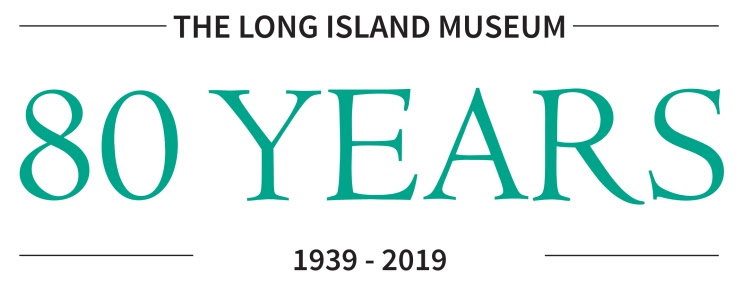
__________________________________________________
===========================================================

AAQ Resources / Transportation: Riverhead Toyota
________________________________________________________________
Source: https://aaqeastend.com/contents/portfolio/long-island-museum-carriage-collection-finest-collection-of-horse-drawn-vehicles/
